The History of the Debt
Select the plus signs below to read about different periods in the history of the debt.
"The United States debt, foreign and domestic, was the price of liberty. The faith of America has been repeatedly pledged for it... Among ourselves, the most enlightened friends of good government are those whose expectations of prompt payment are the highest. To justify and preserve their confidence; to promote the increasing respectability of the American name; to answer the calls of justice; to restore landed property to its due value; to furnish new resources, both to agriculture and commerce; to cement more closely the Union of the States; to add to their security against foreign attack; to establish public order on the basis of an upright and liberal policy; these are the great and invaluable ends to be secured by a proper and adequate provision, at the present period, for the support of public credit."
Alexander Hamilton, 1790, First Report on the Public Credit
Public Debt In America
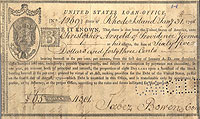
Public debt is a fact of life. The U.S. has had debt since its inception. Our records show that debts incurred during the American Revolutionary War amounted to $75,463,476.52 by January 1, 1791. Over the following 45 years, the debt grew.
Notably, the public debt actually shrank to zero by January 1835, under President Andrew Jackson. But soon after, it quickly grew into the millions again.
The American Civil War resulted in dramatic debt growth. The debt was just $65 million in 1860, but passed $1 billion in 1863 and had reached $2.7 billion following the war. The debt grew steadily into the Twentieth Century and was roughly $22 billion as the country paid for involvement in World War I.
The buildup to World War II brought the debt up another order of magnitude from $51 billion in 1940 to $260 billion following the war. After this period, the debt's growth closely matched the rate of inflation until the 1980s, when it again began to increase rapidly. Between 1980 and 1990, the debt more than tripled. The debt shrank briefly after the end of the Cold War, but by the end of FY 2008, the gross national debt had reached $10.3 trillion, about 10 times its 1980 level.
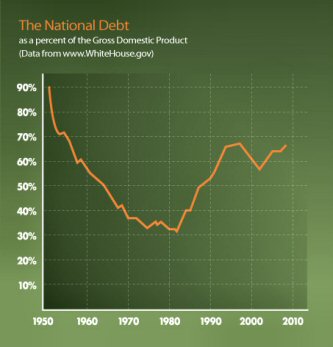
In recent years there has been a "debt ceiling" in effect. Whereas Congress once approved legislation for every debt issuance, the growth of government fiscal operations in the 20th century made this impractical. (For example, the Treasury now conducts more than 425 sales of debt by auction every year to fund $22 trillion in debt operations.) The Treasury was granted authority by the Congress to issue such debt as was needed to fund government operations as long as the total debt did not exceed a stated ceiling. The "ceiling" is routinely raised by passage of new laws by the United States Congress.
Under Public Law 113-83, Temporary Debt Limit Extension Act, the statutory debt limit is suspended through March 15, 2015.
1776: The Birth of Public Debt
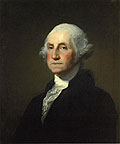
"No pecuniary consideration is more urgent than the regular redemption and discharge of the public debt: on none can delay be more injurious, or an economy of the time more valuable."
George Washington, 1793, Message to the House of Representatives
The public debt of the United States can be traced back as far as the American Revolution. In 1776, a committee of ten founders took charge of what would become the Treasury, and they helped secure funding for the war through "loan certificates" (equivalent to bonds) with which they borrowed money for the fledgling government from France and the Netherlands.
This committee morphed over the next decade into the Department of Finance. Robert Morris, a wealthy merchant and Congressman (nicknamed "The Financier"), was chosen to lead a new Department of Finance in 1782.
As the new Superintendent of Finance, Morris was the first committee member to order a reporting of the total government debt owed. This marked the beginning of annual Treasury reports to the President. On January 1, 1783, the public debt of the new United States totaled $43 million.
1783: Raising Taxes to Meet Operating Expenses
In 1783, Congress was given the power to raise taxes. This helped meet the normal operating expenses of the new national government. But in 1785, revenues were still inadequate. Alexander Hamilton rallied for the government to assume some debt and help meet its expenses. He pushed the framers of the new Constitution to establish measures to provide the assurance that the debt would be paid, and thus increase confidence in the growing government. Many of Hamilton's policies have remained a part of our government's operations ever since. On September 2, 1789, Congress established The Treasury Department, naming Alexander Hamilton, its chief architect, as "Secretary."
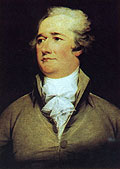
1789: Alexander Hamilton
Alexander Hamilton (b. January 11, 1755 - d. July 12, 1804) was the first United States Secretary of the Treasury, a Founding Father, economist, political philosopher and confidant of George Washington. He was one of America's first Constitutional lawyers, and co-wrote "The Federalist Papers," a primary source for Constitutional interpretation.
As Washington's Treasury Secretary, Hamilton was very influential in the policy decisions of the new government. An admirer of British political systems, Hamilton emphasized strong central government and implied powers, under which the new U.S. Congress funded the national debt, assumed state debts, created a national bank, and established tariffs and taxes. "A national debt, if it is not excessive," Hamilton argued, "will be to us a national blessing."
1790: The Funding Act
Hamilton, estimating the total public debt at $77.1 million, called for the issuance of new federal bonds to cover the debt. By assuming the obligation to pay this debt, the government firmly established its good credit. By February 1792, interest-bearing government bonds were selling for $1.20-on-the-dollar. A shrewd investor, buying $100 in bonds in 1786 (at a market price of about $15) could have sold the replacement bonds issued by the new government for $121.50 in 1792, realizing a handsome profit. The system of debt management instituted by Hamilton worked well to consolidate the debt and permit the government to make interest payments as they came due (as well as to secure the faith and credit of the government in the new United States and abroad).
1791: The Bank
To consolidate the government's financial affairs, Hamilton proposed the formation of a national bank to supplement the activities of The Treasury. Despite the opposition of Jefferson and Madison, the First Bank of the United States opened in 1791 with a total capital of $10 million. Just ten years later, though, Jeffersonian Democrats, who didn't trust banks, overturned this progress. Jefferson's Secretary of the Treasury, Albert Gallatin, was a chief critic of Hamilton's methods of debt management, and made it his priority to reduce public debt. This worked for a time, reducing the public debt to $45.2 million by 1811, but was derailed by Jefferson's "Louisiana Purchase."
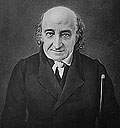
1803: Albert Gallatin
Abraham Alfonse Albert Gallatin (b. January 29, 1761 – d. August 12, 1849) was a Swiss-American anti-Federalist diplomat and congressman, and the longest-serving United States Secretary of the Treasury.
He opposed Hamilton’s entire program, but, faced with declining revenues and the massive cost of the War of 1812, Gallatin was forced to reintroduce the Federalist taxes he had previously denounced. By funding the war deficit ($69 million) with bond issues, he helped defray the costs. He later helped charter the Second Bank of the United States in 1816.
1812: The First Test of Debt
The War of 1812 was financed mainly through the use of borrowed funds. Total public debt increased from $45.2 million on January 1, 1812, to $119.2 million as of September 30, 1815.
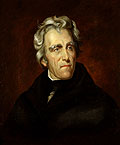
1837: Andrew Jackson
Andrew Jackson, the seventh president of the United States, was suspicious of banks and did not trust the paper money they issued. In 1837, he liquidated the Second Bank of the United States, returning the government’s original investment plus a profit.
This resulted in a huge government surplus of funds. (In 1835, the $17.9 million budget surplus was greater than the total government expenses for that year.) By January of 1835, for the first and only time, all of the government’s interest-bearing debt was paid off. Congress distributed the surplus to the states (many of which were heavily in debt). The Jackson administration ended with the country almost completely out of debt!
1846: Rebuilding the Debt
The United States went to war with Mexico in May, 1846, over the annexation of Texas and California. The total cost of the war was estimated to be $64 million, and Congress authorized the issuing of additional debt to meet these obligations. It is this concept that would later become the basis for the Savings Bond program. By the end of 1849, public debt totaled $63.1 million.
1860: The Civil War
"This war of ours, in its magnitude and in its duration, is one of the most terrible. It has produced a national debt and taxation unprecedented, at least in this country. It has carried mourning to almost every home, until it can almost be said that the 'heavens are hung black'."
Abraham Lincoln, 1864, Speech at Great Central Sanitary Fair, Philadelphia, PA
Public debt in 1860 totaled $64.8 million (the annual budget of the federal government at the time was $63.1 million). But this small debt would look completely insignificant compared to the amount of money the government would owe at the end of the Civil War.
It is estimated that the Civil War cost the nation $5.2 billion in direct expenditures. As the war dragged on, the federal government was forced to completely overhaul its financial organization to cope with this as-yet-unheard-of amount. Enormous leaps in the methods and amount of public financing took place during the war years, including:
- Legal Tender Act (1862) authorized the Treasury to issue $150 million in United States notes and authorized the sale of $500 Million in bonds to fund the war effort.
- National Bank Act (1863) permitting the charter of national banks.
By the end of 1865, interest-bearing public debt stood at $2.2 billion, but the union had been preserved.
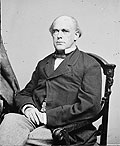
1865: Salmon P. Chase
Salmon Portland Chase (b. January 13, 1808 – d. May 7, 1873) was one of Lincoln’s first political appointees, and served as U.S. Treasury Secretary during the Civil War (and then as Supreme Court Chief Justice of the United States).
Chase was an active and avid abolitionist, and devoted to ending slavery. As Treasury Secretary, Chase oversaw the establishment of a national banking system, which secured a market for government bonds and provided a permanent uniform national currency. The first U.S. federal currency was printed in 1862, during Chase’s tenure as Secretary of the Treasury. He designed the bills (many of which originally featured his likeness).
1899: Dawn of a New Age
At the close of the fiscal year of 1899, the gross debt including Treasury Notes stood at $1.9 billion, and government ended the century with its finances in very good order.
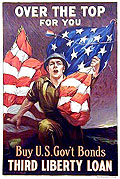
1913: Federal Reserve
The aftermath of the financial panic of 1907 caused many financial experts to rethink the need for a central bank in the United States. Legislation in 1913 enabled the formation of the Federal Reserve System, giving it the responsibility of maintaining flexibility in the money supply, providing a way to rediscount bank loans (by selling loans on a secondary market to increase credit), and overseeing the functions of the banking system. Prior to our entrance into WWI, the Treasury also underwent a process of reorganization.
In 1916, the government prepared for war by raising taxes and authorizing the Treasury to borrow $300 million. Congress authorized the first Liberty Loan of $5 billion, and permitted the Treasury to sell $2 billion in short-term certificates to generate operating revenues.
By the end of 1919, total debt exceeded $25 billion, but the war was won and a great burden of debt had been accepted and managed without causing substantial disruption to the economy.
1920: Reorganization
The Bureau of the Public Debt (established later, in 1940) is a direct descendant of the reorganization of the Treasury Department in 1919 and 1920. What had been the Office of the Register and the Division of Loans and Currency were both placed under a new Commissioner of the Public Debt, who headed the new Public Debt Service. A Division of Public Debt Accounts and Audits was formed to maintain auditing control over these two operations and the public debt efforts of the Federal Reserve. At the time, the number of Public Debt Service employees totaled 3061.
1929: Panic
Through the 1920s, federal budget surpluses got as high as $689 million. Total debt was gradually reduced from $24 billion to about $17 billion. But business activity began to decline in the summer of 1929, and the stock market crash followed in October. By the early 1930s, it was apparent that a major economic crisis was in progress. President Hoover tried to balance the budget, and FDR continued this after being elected in 1932, but bad times forced the deficit up as public works efforts (to offset financial hardships) were funded. By 1933, the budget deficit was nearly $3 billion, and the debt had risen to more than $22 billion. Many economists at the time disdained the attempt to balance the budget "no matter what," and, drawing on the ideas of the English economist John Maynard Keynes, thought that a general fiscal depression was as great a national emergency as a war, and that the government should be willing to use deficits to stimulate the economy, just as it would borrow money to fight a war.
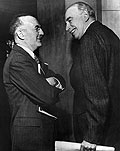
1932: John Maynard Keynes
John Maynard Keynes (b. June 5, 1883 – d. April 21, 1946) was a British economist whose ideas, called "Keynesian economics," had a major impact on modern economic and political theory as well as on many governments' fiscal policies. He advocated an "interventionist" government policy, by which the government would use fiscal and monetary measures to mitigate the adverse effects of economic recessions, depressions and booms. He is one of the fathers of modern theoretical macroeconomics.
1935: US Savings Bonds go to War
The sale of United States Savings Bonds (first offered on March 1, 1935) helped manage the increasing public debt incurred as the country prepared for WWII. (See figure A in the right column)
1940: The Bureau
FDR created the Fiscal Service of the Treasury in April of 1940. As part of this agency reorganization plan, the Public Debt Service was designated the Bureau of the Public Debt. Total public debt was $50.7 billion at the time. But with the coming of WWII, that figure, and the operations of the Bureau itself, would be greatly altered yet again.

1945: WWII
"And so my fellow Americans, I ask you to demonstrate again your faith in America by joining me in investing…"
Franklin D. Roosevelt, 1941, Radio Address
It has been estimated that total government expenditures during World War II were $323 billion.
The effort to fight the war required a total mobilization of the financial resources of the United States; it is doubtful that any citizen was untouched by the war effort. This put great pressure on the fiscal agencies of the government. By 1945, defense expenditures would be 15-times what they were in fiscal year 1941.
Approximately $211 billion of the estimated $323 billion spent fighting the war was borrowed. Treasury attempted (with much success) to manage this borrowing while minimizing its impact on the economy.
To do this, they worked to better tailor securities to meet the needs of purchasers, especially small investors, and encourage savings through the purchase of government securities.
After the First World War, many small investors were disappointed in their Liberty Bonds experience when values fell. To win back these small investors, the Treasury issued Savings Bonds as Treasury non-marketable securities. They were non-negotiable, registered (facilitating easy replacement if lost or stolen), with fixed values, and could be easily turned into cash. This helped make small investors and savers feel more secure. This effort was so successful that Savings Bonds constituted almost 18% of total public debt by the end of the war (helping to pay down nearly $50 billion). The increased reliance on Treasury non-marketable securities also helped Treasury attain one of Hamilton's original goals: widespread ownership of the debt.
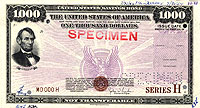
1950: Postwar
There was a budget surplus each year from 1946 to 1949, but the total debt never fell below $250 billion. Fiscal theory no longer centered on balancing the budget, but, following Keynes, took into account the effect that government spending had on economic growth and stability and demanded that government spending should be used as a tool for controlling the economy.
To help bring order to the sprawling post-war bureaucracy, the Bureau of the Public Debt was given new headquarters, and began to take advantage of many new technological advances, like punch cards and microfilm. With the outbreak of hostilities in Korea in June, 1950, defense spending jumped from $17.7 billion to $40.4 billion in 1953, and the Treasury again became concerned with the problem of financing a war effort.
In 1957, Under-Secretary of the Bureau of the Public Debt, W. Randolph Burgess, approved Parkersburg, West Virginia, as the Bureau's new electronic processing center. The new location benefited from its rural location as "a non-critical target area" (this being the height of the Cold War), and enjoyed an abundant local workforce. Soon after, the DATAmatic Corporation is authorized to install a "state-of-the-art" 25-ton DATAmatic Model 1000 computer system, called "The Great Brain," at Parkersburg. The computer alone occupied 6,000 square feet!
1960: Turbulence
No one could have forecast the increase of government activity and debt at the beginning of the 1960s. Up to that time, the post-World War II period had seen only seven years of government deficits (associated with the Korean War or economic recession) mixed with seven years of budgetary surplus. The total debt rose by a modest $30 billion (from $260 billion to $290 billion). And if inflation is taken into account, the real value of the debt would be seen to fall during this time!
The Bureau of the Public Debt grew by leaps and bounds during the '60s, introducing new paper- and time-saving processes to help investors. In 1968, regulations were put into place for the use of book-entry accounting in which Treasury securities would be recorded as entries in the accounts of the Federal Reserve Bank that issued them, instead of as definitive securities issued in the form of printed pieces of paper. This new system reduced the amount of paperwork involved with government securities transactions!

But the war in Vietnam, and the country’s deeper intervention from 1966 onward, as well as the Johnson administration’s "Great Society" programs, raised the budget deficit to $25.2 billion, the most it had been since World War II. With a tax increase, the budget for 1969 actually showed a surplus of $3.2 billion, marking the last time the federal government’s finances would be "in the black" until 1998. (By 1970, total debt would rise to $382.6 billion, increasing $92 billion over the decade.)
1970: Tightening Our Belts
President Nixon inherited the expensive Vietnam War, as well as Johnson’s "Great Society" programs. Deficits rose through the early '70s to levels previously unheard-of except during World War II. In 1973, the budget deficit was $14.3 billion. Then, with the sharp rise in the price of petroleum products due to the OPEC-engineered shortage of 1973, inflation increased dramatically. Monetary policy was tightened to fight inflation, but interest rates hit new highs and the deficit reached $59 billion by 1980.
By 1980 total federal debt stood at $914 billion, an increase of $532 billion since 1970. (Sales of Savings Bonds continued to rise but could not keep pace with the increase in the total debt. At the end of the decade, the total of $72.7 billion in Savings Bonds and Notes was only 8% of the public debt.)
In 1971, Treasury began selling new issues of Treasury Notes for cash at "competitive auctions" instead of employing its longtime policy of offering securities for subscription at fixed prices and interest rates announced in advance. This left it to the financial markets to set prices and rates of interest on the securities, ensuring that each offering could be sold with minimal intervention by the Federal Reserve.
Also in 1971, Public Debt installed a "faster" computer, a Honeywell H-1250, to handle the increased workload from growing savings bond sales. But by mid-decade, the Honeywell gave way to a UNIVAC 1110 computer, which was installed in Public Debt’s first "raised floor" data center at Parkersburg.
Throughout the 1970s, there was an increase in the amount of public debt securities owned by foreign governments. Sales of these securities reached $28.5 billion in 1973.
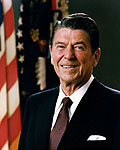
1980: Electronic Age for Treasury Securities
"For decades, we have piled deficit upon deficit, mortgaging our future and our children's future for the temporary convenience of the present.... You and I, as individuals, can, by borrowing, live beyond our means, but for only a limited period of time. Why, then, should we think that collectively, as a nation, we are not bound by that same limitation?"
Ronald Reagan, 1981, Inaugural address
Ronald Reagan (b, February 6, 1911 - d, June 5, 2004), who became the 40th president of the United States in 1980, declared "debt" to be one of his major campaign issues.
Reagan and his advisors were adherents of Milton Friedman (b. July 31, 1912 - d. November 16, 2006), an American Nobel Laureate economist, a promoter of "economic liberalism," and an intellectual renowned for his theories of "consumption analysis." Friedman advocated minimizing the role of government in a free market as a means of creating political and social freedom. This "laissez-faire" style of economics allowed "the market" to set prices and interest rates.

Between 1980 and 1990, the debt more than tripled as the government borrowed money to fund military build-ups and many elaborate new policies, such as "the war on drugs." Americans began relying more and more on credit cards and jumbo mortgages, and being "in debt" became a new way of life in America.
And yet, as the Cold War drew to a close, the economy of the United States remained essentially healthy. How could this be? It is said that the Cold War was fought not by armies, but by banks. From the 1950s through the 1980s, both sides built massive debt during their international shadow-boxing match. Western powers "won" this match not by the size of their debt, but by the nature of that debt, according to a 1995 article in USA Today. "The U.S. financed its battles in the Cold War by borrowing against the future, constraining, but not really limiting, social spending," the article posits. "The Eastern bloc financed its Cold War battles the only way it could: by taking shortcuts on every imaginable count, saving a ruble here... and a ruble there." Thus, when the Berlin Wall came down in 1989, the U.S., guided by policy carried out by the Treasury, was better able to take advantage of economic growth to come.
In 1983, the first "personal computers" arrived at Public Debt, in the Division of Administration, supported (in 1986) by a new IBM mainframe computer system. The new "computer age" brought major changes to the staffing of the Bureau (sometimes resulting in reductions) and to the processing of bonds and other instruments (facilitated by new technologies like optical and magnetic character recognition and advanced scanning).
In 1986, Public Debt introduced Legacy TreasuryDirect, a system allowing investors to buy Treasury securities in book-entry form and hold them directly with Treasury, electronically, without the services of a broker or other intermediary.
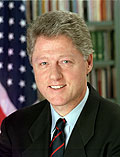
1990: Public Debt Goes Online
Despite backlashes against '80s "greed," and the obstacle of the huge public debt (approximately $3.3 trillion in 1990), the economy of the United States was relatively strong at the start of the new decade. The government made a commitment to "fiscal discipline," and in 1998, President Bill Clinton (b, August 19, 1946) presented to Congress the first balanced federal budget (with no annual deficit) since 1969.
Throughout the '90s, a Wall Street boom drove investment in Treasury securities. Treasury kept up with demand by taking advantage of many technological breakthroughs.
In 1992, Bureau computer systems are again upgraded when the IBM mainframe is replaced with an Amdahl system. It's about this time that (no reflection on the new systems) the first "computer virus" strikes at Public Debt. (It is cured quickly!)
By the mid-'90s, Public Debt was online! The first Bureau of the Public Debt website was on America Online. Soon, users could access Public Debt through a Treasury-managed website, and then, in December, 1997, through Public Debt's own website based in Parkersburg (publicdebt.treas.gov). A new Y2K compliant IBM 9672-R35 CMOS computer replaced the Amdahl mainframe, and new technology finally allowed the mainframe and client/server technology to merge, helping the Bureau itself become more "user friendly."

2000: A New World
While the new millennium began quite auspiciously, terrorist attacks in New York, Pennsylvania and Washington DC on September 11, 2001, seriously undercut the economic progress being made in the United States.
To counter the effects of the economic slowdown and the increased expenditures on national security that followed the attacks, the new president, George W. Bush (b, July 6, 1946), instituted tax cuts and refunds, but the deficit grew, and with it, the national debt.
Meanwhile, Public Debt set about to aggressively take advantage of new technologies for success. The IBM CMOS was replaced with the new, more powerful IBM Z900. Then, in October of 2002, the first version of TreasuryDirect is opened to the public, offering the ability to purchase and manage holdings of Series I savings bonds through a single online portal (www.treasurydirect.gov). Throughout the 2000s, Treasury instituted many more state-of-the-art initiatives for the benefit of investors, including OTC Direct, a web-based system for purchasing paper savings bonds, and FedInvest, an online administration tool for Federal agencies to use when investing in Treasury securities.
Today
In October 2012, the Bureau of the Public Debt consolidated with the Financial Management Service to form the new Bureau of the Fiscal Service.
Today, Treasury's Fiscal Service, with the assistance of the Bureau of the Fiscal Service, continues to help guide, administer and manage US government financial policy for the best possible returns.
Through our massive online resources and state-of-the-art investment and administrative tools, federal agencies and individual investors alike have more access to the world of government finance than ever before.
The Bureau of the Fiscal Service employs nearly 4,000 dedicated, highly-trained people in multiple locations. The success of the bureau today, and of all of its associated agencies and services, is due directly to the commitment, knowledge and enthusiasm of the people who keep the Bureau of the Fiscal Service running smoothly.
- Wholesale Securities Services
- 428 auctions annually
- $61 trillion in bids
- $22 trillion awarded
- Retail Securities Services (at end of 2023)
- $110 billion in 316 million paper savings bonds
- $159 billion in electronic savings bonds and marketable securities held in 3.9 million accounts in TreasuryDirect
- Government Agency Investment Services
- $7.3 trillion invested by 51 federal agencies
- $91.5 billion invested by 1,866 state and local governments
- $2.0 trillion loaned to 22 federal agencies
- Summary Debt Accounting
- $34.0 trillion outstanding
- $26.9 trillion held by the public
- $7.1 trillion held by government accounts
- $284 trillion flow of funds annually
- Franchise Services
- 84 agency customers
- $256.6 million in annual revenue